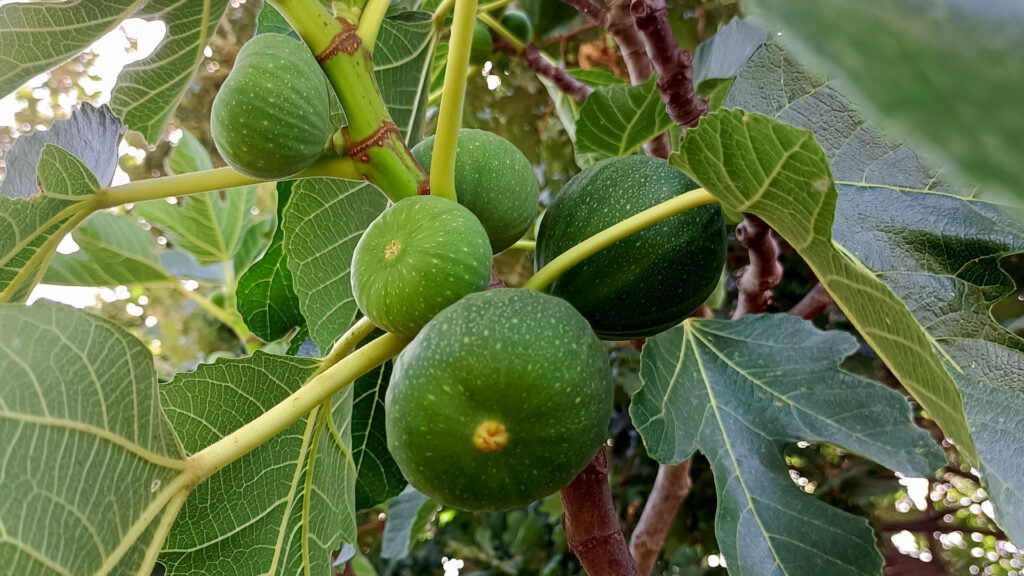
Fico
Appartiene alla famiglia delle Moraceae, ha un portamento arboreo con grandi fogli verdi rugose divise in tre/cinque lobi, e secerne un lattice bianco caustico che un tempo veniva usato per eliminare calli e verruche.
Originaria dei paesi mediorientali, la pianta del fico predilige i terreni calcarei e sassosi, può raggiungere i 10 mt di altezza, i frutti molto dolci e saporiti sono ricoperti da un involucro dal colore variabile dal verde al rosso e si raccolgono tra agosto e settembre. Sono ricchi di ferro, calcio potassio e vitamine che li rendono molto nutrienti ed energetici.
Per la facilità con cui si riproduce, pare sia stata la prima pianta coltivata dall’uomo undicimila anni fà nella Mezzaluna fertile e riveste, nella tradizione antica,un significato di abbondanza e fecondità. I romani pensavano che mangiare i fichi aumentasse la forza dei giovani e migliorasse la salute dei vecchi.
E’ una pianta termofila, vegeta da livello del mare fino ali 800 mt di altitudine, molto diffusa in Sardegna, i suoi frutti sono considerati un buon lassativo e un buon emolliente pettorale.
Fig
It belongs to the Moraceae family, has an arboreal habit with large wrinkled green leaves divided into three/five lobes, and secretes a caustic white latex that was once used to eliminate calluses and warts.
Originally from Middle Eastern countries, the fig tree prefers calcareous and stony soils, can reach 10 meters in height, the very sweet and tasty fruits are covered with a casing ranging in color from green to red and are harvested between August and September. They are rich in iron, calcium, potassium and vitamins which make them very nutritious and energetic.
Due to the ease with which it reproduces, it seems to have been the first plant cultivated by man eleven thousand years ago in the Fertile Crescent and has, in the ancient tradition, a meaning of abundance and fertility. The Romans thought that eating figs increased the strength of the young and improved the health of the old.
It is a thermophilic plant, grows from sea level up to 800 meters above sea level, very common in Sardinia, its fruits are considered a good laxative and a good pectoral emollient.
Figue
Le figuier appartient à la famille des Moracées, a un port arboricole avec de grandes feuilles vertes ridées divisées en trois/cinq lobes, et sécrète un latex blanc caustique qui servait autrefois à éliminer les callosités et les verrues.
Originaire des pays du Moyen-Orient, le figuier préfère les sols calcaires et caillouteux, il peut atteindre jusqu’à 10 mètres de hauteur, ses fruits sont très sucrés et savoureux et sont recouverts d’une enveloppe qui varie de couleur du vert au rouge et sont cueillis entre août et septembre. Ils sont riches en fer, calcium, potassium et vitamines qui les rendent très nutritifs et énergétiques.
De par sa facilité de reproduction, il semble avoir été la première plante cultivée par l’homme il y a onze mille ans dans le Croissant Fertile et a, dans la tradition ancienne, un sens d’abondance et de fécondité. Les Romains pensaient que manger des figues augmentait la force des jeunes et améliorait la santé des plus âgés.
C’est une plante thermophile, pousse du niveau de la mer jusqu’à 800 mètres d’altitude, très commune dans la région de la Sardaigne, ses fruits sont considérés comme un bon laxatif et un bon émollient pectoral.

